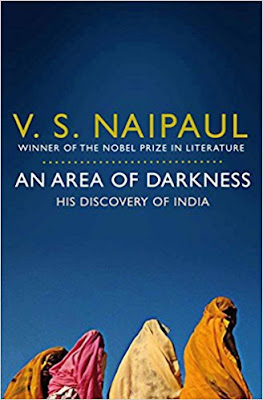This blog post comes after a very long time. I may offer countless reasons for the same but none will be justified now because the lockdown has given ample time for introspection that nothing was or is unavoidable and no work was so urgent that I could have skipped my occasional blog post. If not any gyan or random topic I could have easily put in my book reviews which are though dwindling in number.
So, the first book I completed in the lockdown was “An Area of Darkness” by Sir Vidiya S. Naipaul published in 1964.
I must say that it was my bad luck that I never got opportunity to read V.S. Naipaul due to my myopic vision as I was engrossed with either UPSC CSE related books, investigative journalism or spirituality-oriented topics. This was a random and not a deliberate choice and I must accept that random choice was rewarding and more so like my pet line “Whatever happens, happens for good” and I promise that I’ll be picking more Naipaul’s from the shelves afterwards and share with you all.So, coming to the book which is written in the background of the Naipaul’s visit to India for first time and freshly independent. The preface of the book gives a glimpse of what lies ahead in the book as author has cryptically shared his emotions, the pain and outbursts in it. He was here not as a European tourist but more as a person whose roots are here, the land to which his lineage belonged, the Girmitiyas. The visit which stretched for a year was spent mostly in Mumbai, Kashmir, UP and Delhi with interruptions in between till his final return to England. Though he visited India again but the pain and irritant of this journey was always mentioned by him.
The book is roughly divided into 3 parts with 12 chapters which relate to the destination.In prelude to the book the author takes us for visual retreat of the various port cities like Alexandria, Greece, Karachi and Bombay.
In the first chapter titled “A Resting Place for the Imagination”, the author introduces to his early life, family and upbringing in Trinidad where they settle after migrating from India. There are some sharp observations about the Indian community in Trinidad, the critic of caste system followed in there and the authors aloofness from these beliefs and observations led to his concept of “An Area of Imagination”.

Well done, Anurag.... Though I haven't read this book, your critical review presented here provides valuable insights into the imaginative world of the Nobel Laureate author about the populace of India living both in the cities and country-side. We may call it destiny or anything else, it is widely discernible that many renowned authors within India and abroad have successfully exploited the pathetic conditions of the Indian people on the streets, jughi-jhoopris, etc. ( I wouldn't call it 'a dark side' ) in launching their successful literary expedition often earning national as well as international acclaims including awards of very high recognition, albeit at the cost of depiction of the plight of these havesnot......
ReplyDeleteThank you sir for the read.
Delete